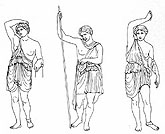Amazons



Mythical warrior women from the distant north-east. There were stories of them fighting Greek heroes (Amazonomachy).
Herakles mounted an expedition against them, a common theme on archaic vases, but only later showing the '
Labour' in which he won the belt of the Amazon queen,
Hippolyte. In some versions she hands over the belt willingly. At
Troy the
Amazons supported
Priam, under their queen
Penthesileia, who was killed by
Achilles, said to have fallen in love with her as she fell. In
Athens they were taken as mythical equivalents to the Persians, and the Persian invasion of Greece inspired the story of an Amazon invasion, thrown back from
Athens by
Theseus.
Theseus had previously gone to their land and carried off their queen
Antiope. They are shown like Greek warriors, but may carry battle-axes and may dress like Easterners (Scythians or Persians). The story of them cutting off one breast is a Greek explanation for their name ('amazon'=breastless) and not shown in art. They were respected foes, could be represented individually (the classical wounded Amazon statues at
Ephesus), and had
hero shrines in Greece. In East Grecce they are involved in foundation stories at
Ephesus and the many Amazonomachies on Greek buildings reflect their role as archetypal eastern adversaries. Being female and foreign, they were regarded as disruptive to the Greek way of life. There is some evidence for women fighting beside their men in nomad cultures (Scythians, etc.), and the lack of facial hair among natives of the far north-east may have added to the idea of female armies. Like the Scythians they were judged redoutable on horseback and with the bow.
In the picture, above left,
Herakles (dressed in his customary lion-skin) attacks an Amazon (right), bringing her to her knees.
Above left: Detail from an Athenian black-figure clay vase, about 550 BC. Boston, Museum of Fine Arts 98.916. © Boston, Museum of Fine Arts, Licence Plate 11 UK 1007 108
Above middle: 'The Ephesus Amazons'. Drawing from John Boardman, Classical Sculpture Fig. 195. © John Boardman.
Above right: Detail from an Athenian red-figure clay vase, about 450-400 BC. Ferrara, Museo Nazionale di Spina 5029. © Museo Nazionale di Spina


